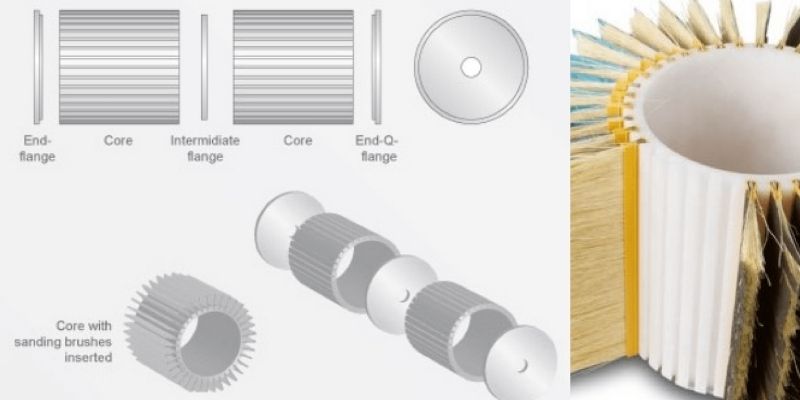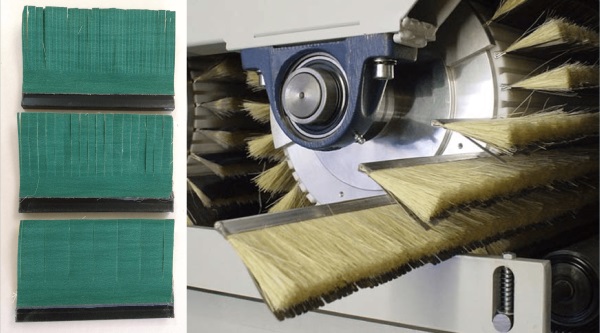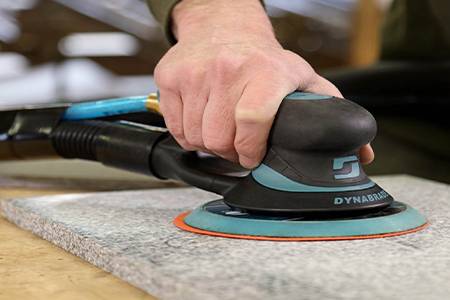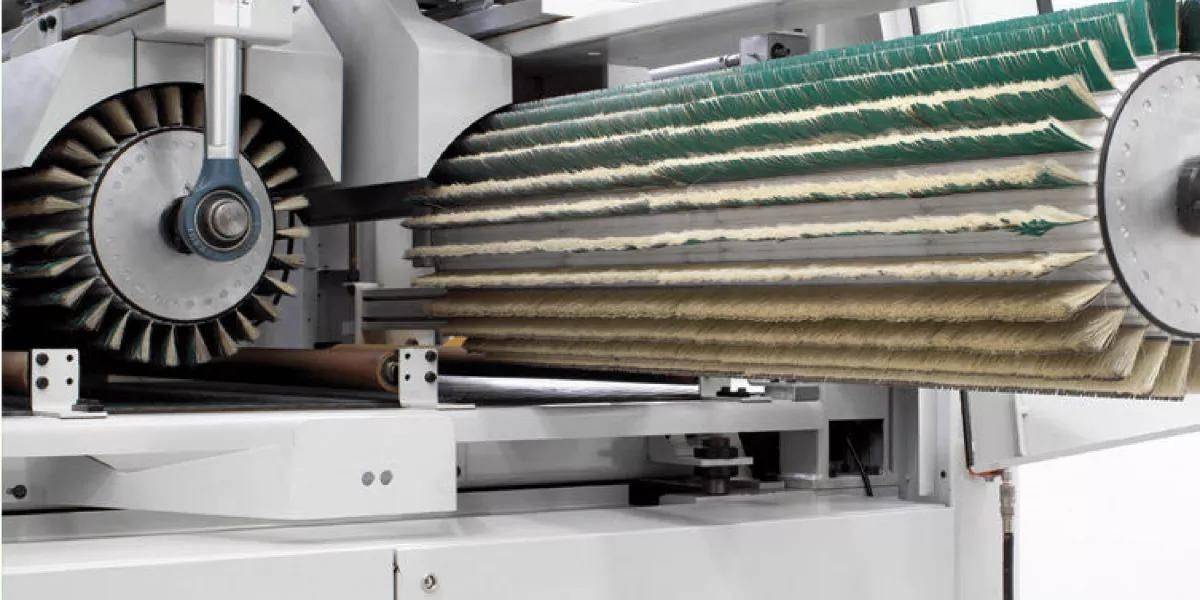¿Necesitas un lijado de precisión sin dañar superficies delicadas? Descubre las ventajas del disco de espuma estándar...
}Sanding brushes, with interchangeable strip system, are commonly used for sanding wooden surfaces, varnished surfaces, fiberboards, plastic parts, composites and metal sheets.
These sanding brushes generally improve the finish of surfaces and give them a better feel and look. They remove fibers and repellency, surface scratches or scratches, snail marks from orbital sanders, as well as cut marks or machining lines.
They also remove the impurities deposited on the lacquered surfaces and create the roughness necessary for the good anchoring of the following finishing layers.
On sheet metal surfaces, they remove the remains of material from the edges and rounding the edges of the pieces, giving the surface a uniform roughness for subsequent finishing.
General recommendations
Sanding brushes are very effective sanding tools and are generally used to reduce sanding times for moldings and profiles, flat surfaces, as well as deburring on metal parts.
Optimum operation of the sanding brushes is achieved at low speeds and with medium sanding pressures. In this way, we guarantee a regular, uniform sanding and extend the useful life of the abrasive.
The composition of the sanding brushes is simple; it is enough to see them with the naked eye to appreciate that they are made up of two different parts:
A fixed part, called the central core or plastic rotor.
An interchangeable part, subject to wear, formed by strips of abrasive cloth reinforced with natural hair fibers anchored on a guide.

Recommendations on the rotor or core.
As far as the rotor is concerned, there are different standard diameters: 50, 80, 100, 120, 180 and 280 mm. Each of these diameters has some defined grooves or sockets: 10, 20, 24, 36 and 54 respectively; in which the guides are inserted with the sanding strips.
It is recommended to always use the largest diameter sanding head possible to achieve smooth sanding with low pressure. In case a more aggressive sanding is required, with higher pressure, it is recommended to use rotors with the grooves arranged in a spiral around the core.
Recommendations about sanding strips
Sanding strips, or abrasive strips, are the most versatile part of the system. They are subject to wear and tear during use and must be replaced when necessary.
There are several options and they are the result of combining the different sanding projections, the different fringe widths and the different types of mineral.
The key is to get the brush settings right, and adapt their characteristics to the shape of the profile and the type of material we want to sand.
Abrasive blades must be manufactured to the highest quality to ensure a strong and durable connection on the fence. Depending on the manufacturer we can find different types of abrasive strips, the most common are:
Sanding strips with metal guide, where the sandpaper and the tampico hair strands are held thanks to the pressure exerted by the metal guide itself as a staple. This system is especially recommended for aggressive applications where high-pressure sanding is required with curved profiles.
Sanding strips with a plastic guide on which the tampico hairs are inserted. The sanding strip is glued to the side of the guide.

Recommendations on the length of the sandpaper strips
As we have mentioned, the sandpaper strips can have different lengths or protrusions. Each manufacturer has standard values, although the difference between all of them is minimal.
The length or projection is a decisive factor depending on the type of operation we want to perform:
The short 20 and 25 mm protrusions are used for aggressive sanding and deburring.
The 30 and 40 mm projections are recommended for aggressive sanding of UV varnishes and flat MDF parts.
The 45 and 55 mm medium bosses behave more flexibly and transmit good sanding pressure for most applications.
Lastly, the longer protrusions, 70 and 85 mm, are suitable for soft sanding in deep profiles.
Recommendations about the fringe of the sandpaper
The sandpaper ends are cut into thin fringe-shaped strips, and the width of the cut is another factor to consider:
For narrow profiles 3, 4 and 5 m wide cuts are recommended.
7 and 14 mm cuts are used for smooth profiles.
For flat pieces and wider profiles, cuts of 20 mm are recommended.
It is advisable to alternate strips with two different widths of fringe. In this way, we avoid that sanding lines are generated on straight surfaces and we achieve better performance on shaped profiles.
On some occasions, when finishing the fringes, the cut of the sandpaper is rounded to improve the uniformity of the finish and avoid scratches on the surfaces.
Recommendations for reinforcement strips
As we have observed, sanding brushes with rotor and interchangeable strips are versatile systems that allow different combinations during sanding jobs.
In addition to the sanding strips, there is the option of reinforcing the sanding operation with additional strips that only contain hair fibers. These reinforcing strips are convenient when higher pressure is required. They are placed alternately together with the sandpaper strips and serve as support for them to behave more aggressively, preventing them from bending backward.
On the contrary, when we need to sand deep profiles, and therefore the projection of the sandpaper is greater, it is convenient to leave an empty groove between the sandpaper strips. For example, in a rotor with 54 divisions we would mount only 27 sanding strips, thus freeing up space so that the sanding strip can bend and act smoothly and less aggressively in the deeper profiles.
Recommendations about the type of mineral
Finally, another factor to consider is the type of abrasive mineral and its choice will depend solely and exclusively on the material we want to sand and the final finish we want to achieve.
Generally, aluminum oxide mineral is used for sanding raw wood and for intermediate sanding of varnish; while silicon carbide mineral is suitable for sanding fibreboard and for fine sanding of varnished surfaces, especially water-based. The highest quality finishes are achieved with silicon carbide ore. While ceramic minerals are used for metalwork.
Sanding brushes are abrasive for industrial use. They are commonly used for the manufacture of interior doors, exterior doors and kitchen furniture doors; Business sectors in which Abracom has been operating for more than 35 years, distributing efficient sanding systems for the wood and its derivatives industry. For any questions or clarification contact us.























 (1).png)
 (1).png)
.png)
.png)
.png)

.png)
.png)
.png)
.png)
.png)
.png)
.png)
.png)
.png)
.png)
.png)
.png)
.png)







